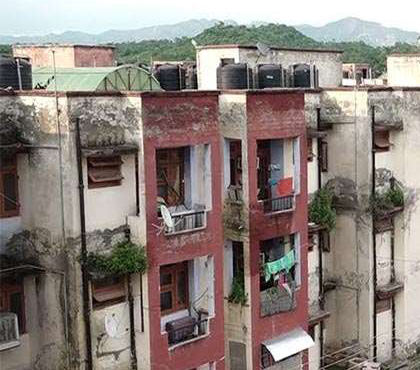 SRI KRISHEN KAW SRI KRISHEN KAW
Residents of Jagti quarters are living in fear as the buildings they call home continue to deteriorate, with leakages in walls and ceilings posing a significant threat to their safety. The dilapidated condition of these structures has raised concerns about the potential for collapse, putting the lives of inhabitants at risk.
*Key Issues:*
*Structural Damage*: Cracks in walls, sagging floors, and weak foundations are evident, indicating a decline in the structural integrity of the buildings.
*Dampness and Seepage*: Visible signs of dampness, including bloated walls and peeling paint, are present due to prolonged exposure to rain and humidity.
*Electrical and Plumbing Issues*: Outdated electrical systems and plumbing infrastructure pose safety hazards, including frequent fuse blowouts, overheating appliances, and leaky faucets.
*Roofing and Flooring*: Water pooling on flat roofs due to poor waterproofing has led to leaks and seepage, further compromising the buildings’ stability.
*Possible Consequences:*
*Collapse Risk*: The combination of structural damage, dampness, and poor maintenance increases the likelihood of a catastrophic collapse, potentially resulting in loss of life and property.
*Health Hazards*: Damp environments can foster mold growth, exacerbating respiratory issues and other health problems for residents.
*Call to Action:*
*Urgent Repairs*: Authorities must take immediate action to address the structural issues, electrical and plumbing problems, and roofing concerns to prevent further deterioration.
*Regular Inspections*: Regular inspections by professionals can help identify potential issues before they become major problems, ensuring the safety and stability of the buildings.
Similar incidents in other cities highlight the importance of addressing such issues promptly. For instance, in Kolkata, over 3,000 buildings have been identified as insecure, with 300 considered extremely dilapidated and at risk of collapse. The Kolkata Municipal Corporation has initiated a city-wide demolition drive targeting highly insecure structures.
Given the current situation in Jagti, it’s unlikely that the area will be safe for living till next monsoon without significant repairs and maintenance. Here’s why
*Dilapidated Buildings*: The buildings in Jagti colony are in a dilapidated condition, with leakages in walls and ceilings, posing a significant threat to the safety of residents.
*Water Crisis*: The area has been facing an acute shortage of drinking water supply, which has generated resentment among residents. The water supply plant, which draws water from the Tawi river, gets submerged during monsoon season, disrupting the water supply for days.
*Poor Maintenance*: Despite spending lakhs of rupees on water supply and maintenance, the supply remains disrupted for weeks. This suggests a lack of effective maintenance and repair, which could exacerbate the safety risks.
*Climate Change*: The region is vulnerable to extreme weather events, including heavy rainfall and flash floods, which could further compromise the safety of the buildings and infrastructure.
To mitigate these risks, authorities should prioritize:
*Urgent Repairs*: Conduct immediate repairs to address the structural issues, electrical and plumbing problems, and roofing concerns.
*Regular Inspections*: Regular inspections by professionals can help identify potential issues before they become major problems.
*Water Management*: Implement effective water management strategies to ensure a steady supply of clean water and prevent disruptions during monsoon season.
*Disaster Preparedness*: Develop and implement disaster preparedness plans to minimize the impact of extreme weather events.
Without these measures, it’s unlikely that Jagti will be safe for living till next monsoon. |
